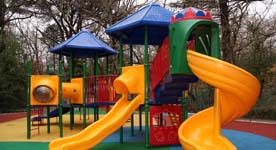Is your public playground a safe place to play?
Each year, more than 200,000 children go to U.S. hospital emergency rooms with injuries associated with playground equipment. Most injuries occur when a child falls from the equipment onto the ground.
Use this simple checklist to help make sure your local community or school playground is a safe place to play.

Public Playground Safety Checklist
- Make sure surfaces around playground equipment have at least 12 inches of wood chips, mulch, sand, or pea gravel, or are mats made of safety-tested rubber or rubber-like materials.
- Check that protective surfacing extends at least 6 feet in all directions from play equipment. For swings, be sure surfacing extends, in back and front, twice the height of the suspending bar.
- Make sure play structures more than 30 inches high are spaced at least 9 feet apart.
- Check for dangerous hardware, like open "S" hooks or protruding bolt ends.
- Make sure spaces that could trap children, such as openings in guardrails or between ladder rungs, measure less than 3.5 inches or more than 9 inches.
- Check for sharp points or edges in equipment.
- Look out for tripping hazards, like exposed concrete footings, tree stumps, and rocks.
- Make sure elevated surfaces, like platforms and ramps, have guardrails to prevent falls.
- Check playgrounds regularly to see that equipment and surfacing are in good condition.
- Carefully supervise children on playgrounds to make sure they're safe.
View All Playground Safety Guides
Brought to you by the U.S Consumer Product Safety Commission and KaBOOM!, a national nonprofit organization committed to building safe playgrounds for America's children through the KaBOOM! LET US PLAY campaign. For more information, call toll-free 1-888-789-PLAY or visit the KaBOOM! web site at www.kaboom.org.

